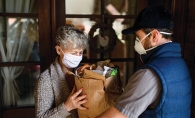
Giving Gardens is the link between people in need and people who want to make a difference in their community. The organization is making an immediate impact on food insecurity in Hennepin and Ramsey county, paying special attention to citizens who don’t fit the immediate criteria for emergency assistance.
Food insecurity affects 12% of people in the Hennepin County and 13% in Ramsey County (according to CountyHealthRankings.org and FeedingAmerica.org) and Christopher Harms, founder and leader of Giving Gardens, plans to change that by asking volunteers to donate food grown in garden beds that Giving Gardens will build for them—for free.
Giving Gardens is an organic movement based in White Bear Lake born to foster sustainable community values, and the formula is pretty simple. Sign up, receive a ready-made garden bed at no charge, grow food, donate food. Giving Gardens can provide the seeds and will even pick up the food for free. Donated food is then distributed by Giving Gardens volunteers to neighbors in emergency need of healthy meals.
“The idea for giving gardens was largely collaborative,” Harms said. “A call to action, and putting faith into an impactful movement in the community is a very important thing to offer others.”
Elderly citizens, those with restricted mobility, and working families are the main recipients of donated food. “It could be your neighbor next door,” Harms said. “This is about peeling away the camouflage of poverty in the community, to rise up and help your neighbors. That’s what sustained community is all about.”
Giving Gardens is dedicated to supplying the garden beds free of charge to those who wish to “adopt”. They will supply the 4’x8’ raised bed structure, dirt, and seed, and volunteers provide the space and the gardening skills. Lumber donations are supplied by Universal Forestry Products and Structural Wood Corp. in White Bear Lake and J.L. Schwieters Lumber Supply in Hugo. In addition to the lumber commitments, Rehbein’s Black Dirt in Hugo offered to provide nutrient-rich, screened topsoil at a significantly reduced cost and free delivery. However, residents are welcome to donate from their pre-existing garden.
Emergency food shelves are in every community, and churches and schools already host food drives. However, Giving Gardens is not a canned food drive. What makes Giving Gardens unique is that it “wants to do is be an energetic friend in the community. We want to make the food shelves better,” Harms said. “We want to be made up by the community for the community and bring fresh produce to those who need it. Straight from our vine to the food shelf. We want to fill in the gaps that food shelves can’t, redistribute fresh produce between organizations. We aim to be nimble.”
The organization has planted over 50 garden beds in the community as of July, at homes, businesses, churches, and other places. As of July 11, they were only $225 away from meeting their goal of $1800 on their GoFundMe account to cover material costs and printing grant applications for the summer. However, this will be taken down soon to make way for the new season. They rely on word-of-mouth, social media posts, lawn signs, newspaper articles, and other community message boards to spread the word about their mission. Harms has found support almost everywhere they’ve planted the idea. “I am still blown away and speechless in describing the enthusiasm and support people have shown this project,” Harms said.
For the harvest season this fall, they look forward to accepting help from volunteers to plant 50 more gardens by October, 19 of which are already claimed. They hope to set up a Meet and Greet for participants and volunteers, present in front of potential sponsors, and set up a website for 2018. They are particularly in need of volunteers to pick up produce from various locations, or for gardeners to deliver their produce to the recipients personally.
“Really challenge yourself to go with open eyes and an open heart, and be prepared to challenge that traditional concept of suburban poverty,” Harms said.









